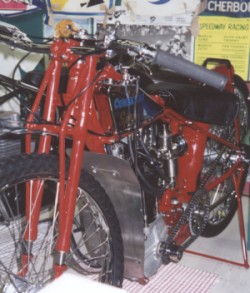

In the early days of dirt-track racing Messrs. Comerford-Wallis Engineering Co.Ltd., of Thames Ditton, Surrey, produced the Wallis Dirt-track Special, a machine which was used to a considerable extent. It was designed to take almost any standard racing engine of 350cc. or 500cc. Outstanding features in its design were the short wheelbase frame, embodying the Wallis patent lug wherever great strength was required, a special design of racing forks with a very short movement, and the provision of nuts requiring only two spanner sizes for the whole machine.
However, as far back as 1929, when
the Wallis was produced, it was obviously impossible to design a dirt-track
machine approaching anything like perfection. Since those early days a large amount of data
has become available, and the above-mentioned firm, after carefully considering
the defects in the original Wallis and much experimenting, have evolved
a machine which, although incorporating the best characteristics of the
Wallis, is in the main an entirely new design. It is known as the Comerford-Special.
During 1932, this machine, sometimes referred to as the "Hush-Hush" type,
gained much prestige in the dirt-track world, and is being manufactured
for 1933 with very slight alterations,
which consist of a slightly longer
wheel base and more flexible rear stays, so as to improve further the stability
of the machine when broadsiding.
The Comerford-Special has the following
specification.
Frame and
Forks.-the sturdy design of the frame, which is coslettised
and enameled black. A single front
down tube is used, but this, at its upper end, is joined to a particularly
massive steering Head of forged steel.
 Incidentally, all lugs are drop forgings and every joint is brazed. Reynolds
Aero quality cold-drawn steel tubing is used throughout. The rear forks
and seat stays incorporate the Wallis patent lug, which gives immense strength.
Incidentally, all lugs are drop forgings and every joint is brazed. Reynolds
Aero quality cold-drawn steel tubing is used throughout. The rear forks
and seat stays incorporate the Wallis patent lug, which gives immense strength.
The fork has a pair of very stout
and dead-straight blades, braced at the front by two thinner members arranged
so as to constitute a rigid girder able to resist all torsional stresses.
There are no side links whatever, the springing
being of a novel design. The fork
blades at the bottom have telescopic prong members with internal springs.
As may be noted in the illustration, the fork action is limited by flanges
on the lower telescopic members to a very small movement. Immediately in
front of the heavy upper lug joining the main fork blades is a split lug
for mounting the handlebars, thus providing a good forward position and
adjustment for any desired angle. A special shock absorber is provided,
in addition to the Andre steering damper over the steering head.
Tank.
- The tank, which is originally distinctively panelled in red, is mounted
on rubber insulators to protect it from damage. It holds 1 gallon of fuel
and 1 quart of oil. On the left-hand side is a Best and Lloyd positive hand-operated
pump with a 5/16-inch oil-pipe union for connecting the mechanical pump
on the engine.
Transmission.
- A countershaft is provided, but no clutch. The countershaft, which is
a 7/8-inch-diameter nickel-steel shaft, is mounted on Timken tapered roller
bearings, carried in a cast-aluminium housing. The two sprockets are splined
to the countershaft and have 42 and 15 teeth. Has Reynolds chains of extra
heavy type, measuring 5/8 x 1/4 inch, are used for both primary and secondary
transmissions, but a 5/8 x 3/8 inch chain is also available for the secondary
drive, which may be arranged on the near or off side at the riders option
Wheels and
Tyres.
- The wheels, which are chromium plated with heavy rims
and 10-gauge spokes, have Timken tapered roller-bearing hubs, and the front
one has a knock-out spindle. The chain wheel has 52 teeth. The wheels are
shod with 2 3/8-inch Avon or Dunlop dirt-track tyres.
Miscellaneous.
- Included in the specification are dropped racing-type chromium-plated handlebars, which are adjustable for angle and provided with an Amal twist-grip for the throttle, with dummy to match; a special Lycett narrow Aero seat with three-point suspension; a quickly detachable rear stand of pressed steel; a lifting handle made of steel strip with mudguard running between this and the bottom chain stay ; a quickly detachable, rubber-covered foot rest, and a knee hook.
THE COMERFORD-SPECIAL JAP MACHINE
Messrs. Comerford-Wallis Engineering Co. Ltd, who, it may be mentioned, are distributors of Jap racing engines, market besides the Comerford-Special frame assembly and the Comerford racing forks, a complete machine with a 498c.c. single-port Jap speedway engine, inclined slightly forward in the frame. This machine, is known as the Comerford-Special Jap. It has a large-diameter straight-through exhaust pipe, a twin float chamber, Amal carburettor with triple-gauze filter, and a racing B.T.H. magneto with platinum-iridium contacts.
From the Speedway Workshop Archive